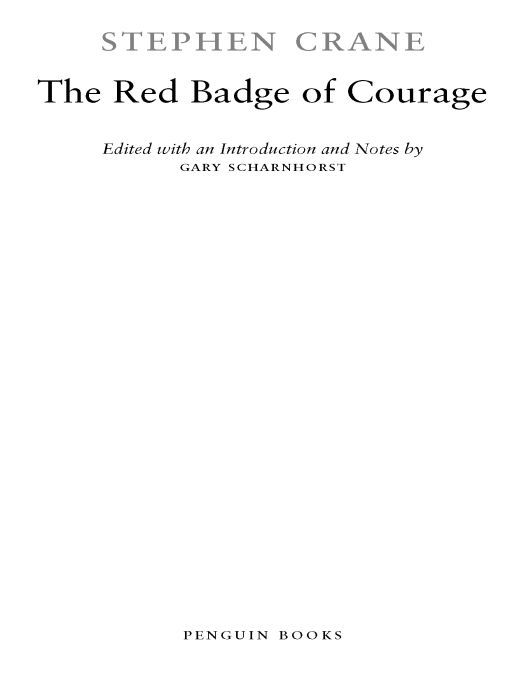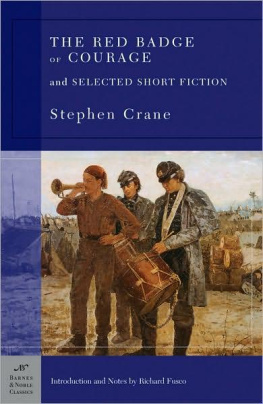Table of Contents
PENGUIN

CLASSICS
THE RED BADGE OF COURAGE AND OTHER STORIES
STEPHEN CRANE was born in 1871 in Newark, New Jersey, the youngest of a family of fourteen children. His father was a prominent Methodist minister and his mother, niece of a Methodist bishop, was a leading churchwoman. After brief attendances at Lafayette College and then Syracuse University, Crane joined his brothers news agency in New Jersey and, while continuing to pursue freelance journalism, drifted into the bohemia of lower Manhattan. His first novel, Maggie: A Girl of the Streets (1893), failed to find a reading public but was enthusiastically received by Hamlin Garland and William Dean Howells, who encouraged his literary career. With his next novel, The Red Badge of Courage (1895), he became an instant, international celebrity. As a journalist Crane reported from the American West, Mexico, Greece, and Cuba, as well as New York, and also converted a number of his experiences into fiction. The stories and sketches he wrote following the composition of The Red Badge of Courage are among the finest short works in all of American literature. In 1899, Crane and his wife, Cora, settled in England, where his tubercular condition was aggravated by the relentless work schedule he undertook in order to meet his debts. He died in a sanitarium in Germany in June 1900.
GARY SCHARNHORST is editor of American Literary Realism and editor in alternating years of the research annual American Literary Scholarship. He has held Fulbright fellowships to Germany and at present is Distinguished Professor of English at the University of New Mexico. He has published books on Mark Twain, Charlotte Perkins Gilman, W. D. Howells, Bret Harte, Horatio Alger Jr., Nathaniel Hawthorne, and Henry David Thoreau.
Introduction
Stephen Crane (1871-1900) was a supernova in the American literary firmament in the 1890s, bursting upon the scene and burning with intense energy for several years before dying prematurely. Yet so prolific was he during his brief careera period that coincided with the most severe economic crisis in America before the Great Depression of the 1930sthat the standard edition of his complete writings contains ten thick volumes of fiction, poetry, and reportage. Like other authors of realistic tales, including W. D. Howells, Theodore Dreiser, Hamlin Garland, and Willa Cather, Crane was trained as a journalist. But in his best writings he pushed beyond realism to irony, parody, and impressionism. Crane was both an apprentice and a pioneer, simultaneously learning his craft as he changed the course of American literary history. Who knows how much more he might have accomplished had he lived? At his death he was eleven years younger than Mark Twain had been when he published The Adventures of Tom Sawyer in 1876, exactly the same age as Theodore Dreiser when he published his first novel Sister Carrie, eleven years younger than Willa Cather would be when she published her first novel in 1913. Yet the brevity of his life is part of the legend of the hard-drinking, hard-living bohemian. Before The Red Badge of Courage was published, I found it difficult to make both ends meet, he once admitted. It was an effort born of pain.... It seems a pity that this should be sothat art should be a child of suffering, and yet such seems to be the case.I
Born to a teetotaling Methodist minister and his wife in Newark in 1871, Stephen Crane moved with his family to Port Jervis, New York, in 1878. Between 1888 and 1891 he attended Claverack and Lafayette Colleges and Syracuse University, where he seems to have majored in baseball. I began the battle of life with no talent, no equipment, but with an ardent admiration and desire, he reminisced shortly before the publication of The Red Badge of Courage. I did little work at school, but confined my abilities, such as they were, to the diamond. Not that I disliked books, but the cut-and-dried curriculum of the college did not appeal to me.... And my chiefest desire was to write plainly and unmistakably.
In June 1893, after reading a series in Century magazine on Battles and Leaders of the Civil War, Crane began to write The Red Badge of Courage. As he later explained to his friend Louis Senger, I deliberately started in to do a pot-boiler... something that would take the boarding-school elementyou know the kind. Well, I got interested in the thing in spite of myself, and I couldnt, I couldnt. I had to do it my own way. Crane completed a draft of the story in early April 1894 while living in the Art Students League building in New York. He was only twenty-two years old. After Garland read the story in manuscript and suggested a few changes, Crane submitted it to S. S. McClure to consider for publication in McClures Magazine or by his newspaper syndicate. After receiving a noncommittal response from McClure, however, Crane retrieved the manuscript in October and submitted it to Irving Bacheller, whose syndicate serialized a truncated version of the story in several major newspapers, including the Philadelphia Press, the following December. On the basis of this serialization, Ripley Hitchcock, the chief editor of D. Appleton and Co., accepted the novel in February 1895 for book publication. Meanwhile, Crane was traveling in the West and Mexico, and after his return to New York in May he signed a contract with Appleton that provided for a standard 10 percent royalty on all sales of the novel. After Current Literature excerpted part of a chapter in its August issue, The Red Badge of Courage, only the second novel by a virtually unknown young writer, was formally published on September 27.
It was an immediate sales success, with two or three printings in 1895 and as many as fourteen printings the following year. Its critical reception was more mixed, however. On the one hand, many reviewers, especially in England, were impressed by the realism of its battle scenes, ranking The Red Badge of Courage with Tolstois War and Peace and Zolas La Dbcle. Edward Marshall averred in the New York Press, for example, that only Tolstoi had described as vividly as Crane the curious petty details of personal conduct and feeling when the fight is thickest. In the New Review, George Wyndham, the British Undersecretary for War, opined that Crane realized by his singleness of purpose a truer and completer picture of war than either Tolstoi or Zola. Harold Frederic, the London correspondent of the New York Times, insisted that the novel impels the feeling that the actual truth about a battle has never been guessed before and compared Crane with Tolstoi, Balzac, Hugo, Mrime, and Zola.and, indeed, he describes in chapter XIX how his protagonist Henry Fleming runs for cover with his head low, like a football player.
On the other hand, some readers objected to Cranes ostensible failures of verisimilitude in the novel. A. C. McClurg, a Civil War general, dismissed it as nothing more than a vicious satire upon American soldiers and American armies and a mere work of diseased imagination which ignored entirely the quiet, manly, self-respecting, and patriotic men, influenced by the highest sense of duty, who in reality fought our battles. William M. Payne, editor of the


 CLASSICS
CLASSICS


